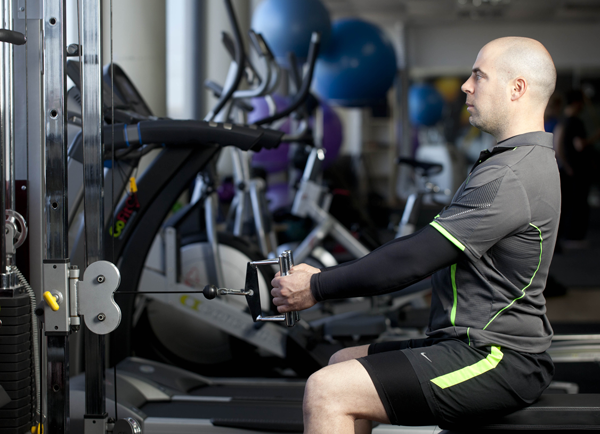Personal trainer Ben Masci suggests a gym-based routine to enhance your bike fitness.
Some cyclists are looking for an extra edge to their training. Whether it’s improving for a race or event, or just to improve overall health and fitness, a regular visit to your local gym or personal trainer can help you get the improvements you’re looking for by building overall strength.
With the addition of the following resistance and aerobic training exercises you will notice improvements in upper-body strength, core and postural stability, and leg conditioning as well as improved physical fitness. All of these improvements are beneficial in helping build a strong foundation for cycling, and those looking for further performance gains will notice greater strength output and faster recovery. This workout consists of compound exercises (training numerous muscle groups at once) that are very time-efficient and produce excellent gains in general health and performance.
This routine can be done as a circuit where a single set of each exercise is performed immediately after the other for three full rounds, or as a traditional ‘set/rep’ routine where you would perform three sets of 12 repetitions for each exercise then move on to the next. The workout intensity will vary based on the load of weight and recovery time. The whole routine should take between 30–45 minutes.
For the best program for your individual needs, see your doctor or a fitness professional.
Swiss ball chest press
Incorporating a swiss ball in any exercise adds an element of instability, resulting in the body needing to recruit stabiliser muscles to assist with the movement. Stabilisers strengthen joints and core muscles and are beneficial for joint mobilisation. Riders of all levels will definitely benefit from more efficient joint mobilisation as muscles and tendons are generally much tighter in cold weather and take longer to warm up.
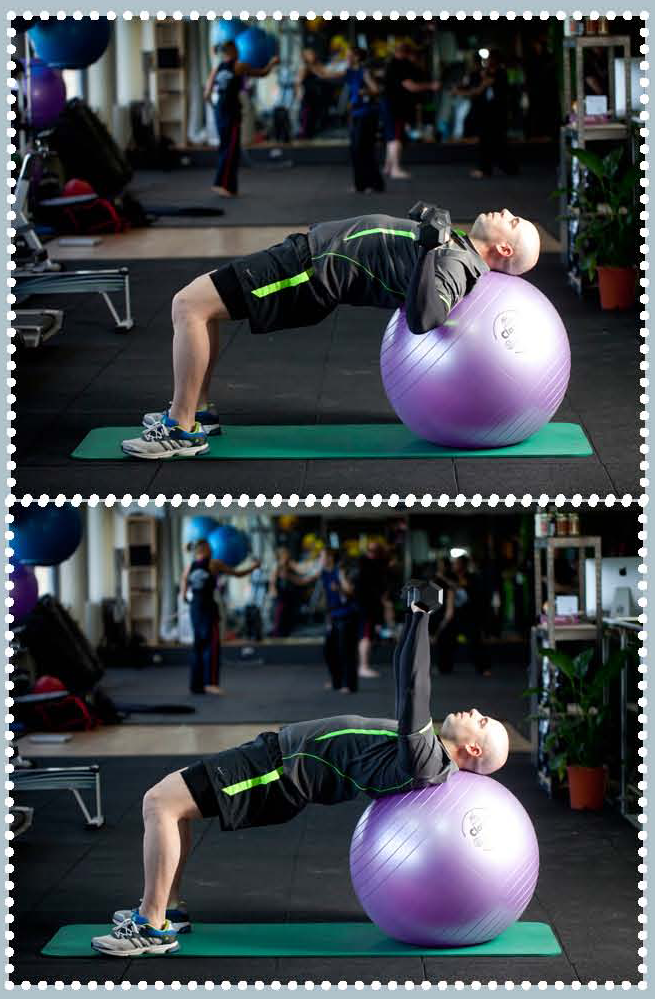
- Begin by sitting on a swiss ball with your knees bent in front of you.
- Slowly walk your feet forward and roll your back down the ball until you’re in a lying position facing upwards. The ball will be situated under your upper back.
- With your head lying back on the ball, you can commence raising weights from your chest towards the ceiling and back to your chest.
This exercise is best performed with the aid of a trainer to assist with handling the weights.
Cable seated row
For many cyclists, hours spent leant over the handlebars has a weakening effect on the postural muscles that prevent ‘slouching’. Very few riders spend time correcting and strengthening these muscles. The cable seated row involves movement that recruits muscles of the upper back and shoulders that will prevent poor posture.
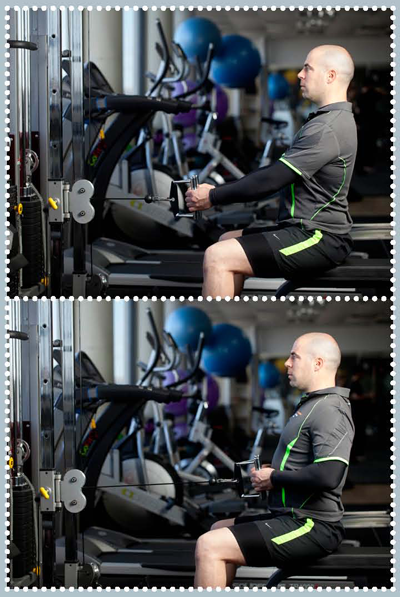 Sit on a bench opposite a cable machine with your feet firmly planted on the ground.
Sit on a bench opposite a cable machine with your feet firmly planted on the ground.- While gripping a rope or bar handle connected to the cable pull towards your body until you reach your belly button.
- For full muscle recruitment, squeeze the back of your shoulder together during the pull phase.
- Allow the cable to return to the machine slowly and with control to prevent your body leaning forward.
Oblique raises
This exercise targets the oblique muscles that run along the side of the body’s midsection and core. Strong obliques are beneficial to your posture and diaphragm. These muscles also work as anchor points to the leg muscles, such that when the leg muscles tire from cycling a long distance or up a steep grade, strength can be gained from your obliques resulting in increased power output from the legs. The ‘swagger’ that is commonly seen as riders fatigue can be a result of weak oblique core muscles.
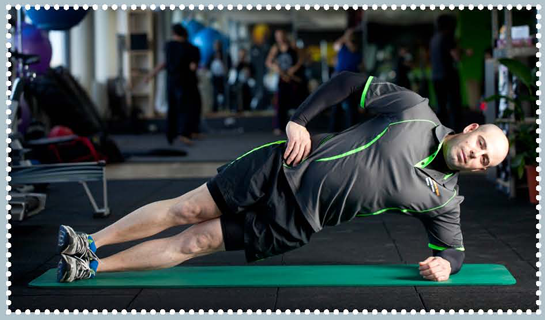 Lay on your side with your forearm on the ground propping up your upper body.
Lay on your side with your forearm on the ground propping up your upper body.- With one leg resting on top of the other raise your hip off the ground so that you support your weight on your bottom leg and forearm (making a sideways plank).
- Lower your hip again and raise to repeat.
Repeat for both sides.
Pelvic raises
Strengthening your gluteus and lower back muscles while off the bike is very important to maintain strength and compensate for the wearing and overuse with so much time spent on the bike. During the colder months it is very easy to neglect your back especially when you finish a ride and your body feels warm. As you cool, your back muscles can seize and cause a great deal of pain. Pelvic raises target the lower back and can be utilised as an everyday range-of-motion stretch as much as a strength and conditioning exercise. It is also a low impact conditioning movement for your hamstring and gluteus muscles resulting in greater strength and elasticity in the muscle complex of the upper legs.
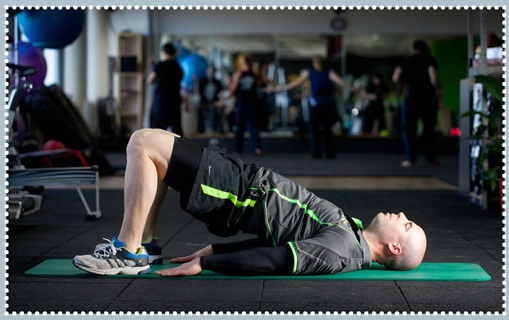 Lay on your back with your arms by your sides and hands flat on the ground.
Lay on your back with your arms by your sides and hands flat on the ground.- Bend your knees and shuffle your feet to your bottom or fingertips.
- While pushing against the ground with your arms, raise your hips upwards as high as you can then lower back down.
Medicine-ball squats
This exercise is very much a full body workout on its own! Leg muscles are strengthened with the squat element, while core muscles activate to maintain correct posture. Arms and shoulders are trained by raising the heavy medicine ball above your head and lowering it.
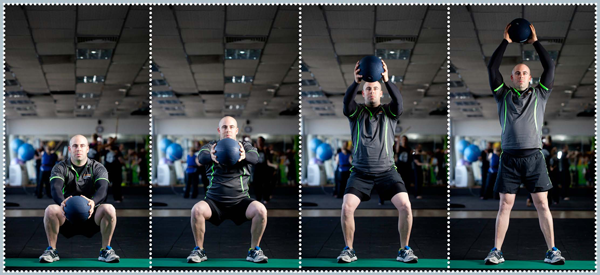 With a medicine ball ready in front of you, stand with feet shoulder-width apart.
With a medicine ball ready in front of you, stand with feet shoulder-width apart.- Perform a squat to lower your body. Keep your head up and be sure to stick your backside out backwards rather than lean your knees forward. Your heels should remain on the floor.
- Pick up the ball and raise it above your head with straight arms as you stand to an upright position.
- As you squat back down, gradually lower the ball to the floor.
Repeat 12 times to complete 1 set or for a high intensity aerobic workout try to continue for 60 seconds.
Battle ropes
Often used in boot-camp workouts and even military training, the battle ropes provide a high-intensity cardiovascular and respiratory system workout. It is also a low impact strengthening exercise for your arms and shoulders and can be performed in a squat position to target legs as well.
These are best use intervals, with 30 seconds of rope throws at 100% intensity followed by 10 seconds rest, then immediately back to 100% intensity. You continue for three minutes to complete one set.
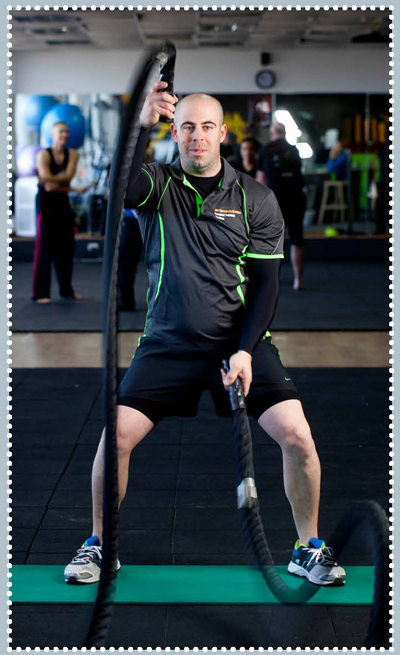 Stand in a squat position gripping a rope in each hand.
Stand in a squat position gripping a rope in each hand.- Flick each rope as hard as you can with alternating arms in rhythm.
- Maintaining momentum is your focus as your arms fatigue the rope feels heavier and harder to throw.
- Be sure to maintain the squat position and brace your core muscles to keep correct posture.
Benjamin Masci (BExSci) is an exercise physiologist and personal trainer with a love of cycling.
Photos by Arsineh Houspian. Thanks to Alterego Fitness Studio for hosting our photoshoot.
Ride On content is editorially independent, but is supported financially by members of Bicycle Network. If you enjoy our articles and want to support the future publication of high-quality content, please consider helping out by becoming a member.

